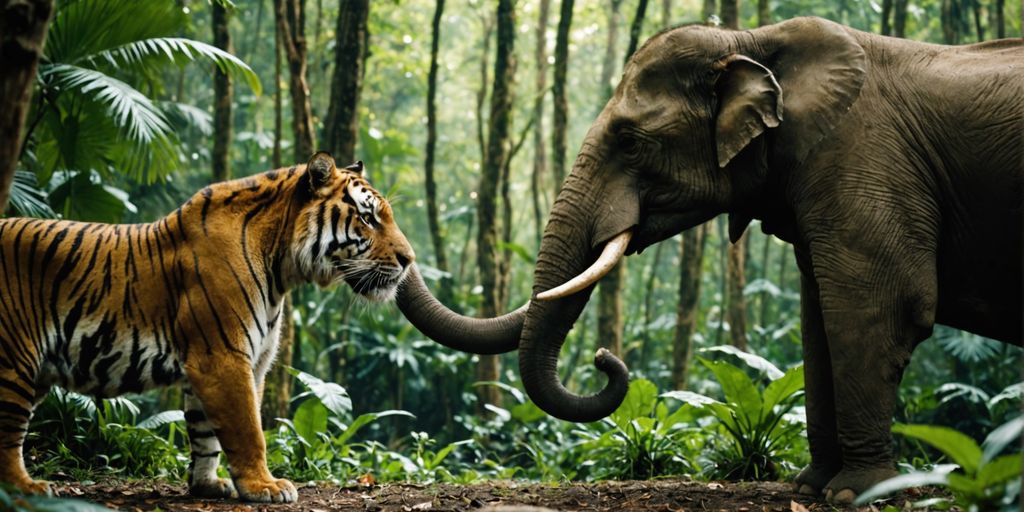Your Cart is Empty
🙏HELP US SAVE TIGERS!🐅 WE DONATE 1% OF OUR SALES TO WILDLIFE ORGANIZATIONS ( WWF ...)
Menu

🙏HELP US SAVE TIGERS!🐅 WE DONATE 1% OF OUR SALES TO WILDLIFE ORGANIZATIONS ( WWF ...)
When did the South China Tiger become Endangered?
May 28, 2021 6 min read

Did you know that the South China Tiger is one of the most endangered animal species? Indeed, this poor beast has seen its population drastically decline over the decades. But if you are here, it is doubted because you are already aware of the current situation of this beast. Don't worry, because you still have many things to discover about the Chinese Tiger!
Whether it's about its history, its particularities, or the projects implemented to save it, this species endemic to China is full of anecdotes. Before starting, we strongly invite you to consult our article on the influence of the Tiger in China to be sure to understand everything.
Let's not waste another second, and let's immediately start our journey in the heart of the Middle Kingdom. The fabulous Asian feline is waiting for you!
The history of the Chinese fawn
1) The specificities of the species

The South China Tiger was once found throughout the southeastern part of China, even beyond the borders of the Empire!
This subspecies of the striped fawn is easily identifiable by looking closely at its coat and skull. Indeed, the stripes of the Chinese Tiger are finer and more numerous than those of the other species. In addition, its coat is much lighter and more orange than that of its cousins.
On the level of its skull, it has canines and molars much smaller. Generally speaking, the Chinese Tiger is smaller than other species of Tigers such as the Siberian Tiger or the Bengal Tiger. However, it is still more massive and imposing than the island Tigers, with a weight of up to 180 kg and a length of between 3m10 and 3m50 for the males.
So we can see that the Chinese fawn is a very particular species. But unfortunately for it, this last one will know disastrous events which will put at evil its survival.
2) A spectacular decline

Scientists today have very little information about the life of the Chinese Tiger in the 19th century. It seems that at that time, the species was only known by local villagers. This way, we can suppose that it evolved peacefully in its native land.
Everything was going well for this striped fawn until the fateful year of 1950. At that time, Mao Zedong, the Chinese communist dictator, decided to implement his famous economic recovery project: "the great leap forward." Following this, vast uncontrolled hunts, as well as massive deforestations, are born. Thus, the Tiger becomes, despite itself, the enemy number 1 to be slaughtered for the Chinese.
As you can imagine, this will have catastrophic consequences on the species. As proof, there were nearly 4000 Tigers before 1950, while there were only about thirty left at the end of the 1990s.
Therefore, we can see that the history of the second half of the 20th century has dramatically played against the South China Tiger. This will lead it to be classified as critically endangered.
A species in danger of extinction

Nowadays, the Chinese Tiger population is still in great danger. Many types of research made to estimate the number of specimens still alive in the wild are alarming. In the early 2000s, the territory of these tigers was inspected to observe them directly at best or at worst to find traces that would allow us to estimate their numbers.
In your opinion, what were the scientists' estimates concerning the number of Tigers in the wild?
Well, it's straightforward, after traveling several thousand kilometers, installing hundreds of cameras, analyzing every little detail that could attest to their presence. They found no evidence, not even a footprint that even one South China Tiger was still alive.
Despite this, a few years later, a Chinese farmer would share photos of what he claimed was a Chinese Tiger. Although the news was good at the time, many researchers doubt the veracity of the images and point to a photo montage. First of all, the animal photographed looks strangely like a Bengal tiger. In addition, it seems unlikely that the latter has been photographed several times when we know the very solitary character of Tigers.
Anyway, even if there are still Chinese Tigers living in the wild. Their population is so low that it seems unlikely that they will be able to revive the species independently.
Before you read on, we invite you to look at our latest CHINESE TIGER GUSSET WATCH specially made in honor of the Chinese Tiger!
Projects to save the South China Tiger
1) Conservation in captivity

Seeing that the conservation of the species in the wild would be complicated, the Chinese authorities chose the easy way out by capturing South China Tigers. These cats are found in several zoos in the country, and there are about 70 of them. However, there are few purebred Chinese Tigers among them because many have been crossed with other subspecies.
Even if the captive population of these big cats is constantly increasing, we have the right to ask ourselves if it is perfect for the species to take away all its predatory habits. Because of living in zoos, the cats quickly lose their hunting skills and thus no longer know how to feed themselves.
Therefore, this project set up by China was necessary but not sufficient if we want to see the Chinese tiger one day become what it used to be: an outstanding hunter!
That's why several initiatives were born to reintroduce the species in a wild environment. You will see in this last part that, despite the failures, some results are encouraging.
2) Attempts to reintroduce the species in the wild

Ambitious projects wanted to release some Tigers in their natural environment and see if they succeeded in adapting to it. The results were catastrophic because, as we told you before, the Chinese Tigers that had evolved all their life in captivity were no longer able to hunt. Following this failure, the organization Save China's Tiger looked into the matter and found a more viable and promising solution.
In collaboration with South Africa, the latter signed an agreement to construct a reserve in this resource-rich country. The objective was to implant young Chinese tigers and gradually hunted alone.
But why South Africa in particular?
This country is one of the wealthiest and most diversified prey to hunt. This way, the cats would have no trouble finding a target and stalking it.
This project was a success because the Tigers implanted in 2002 succeeded in adapting perfectly to the African environment. They did not need any help from humans and could hunt entirely autonomously. At the same time, a second reserve was built in China to welcome the young of these African Tigers!
Thus, the Chinese authorities plan to build new reserves on their territory, far from the local populations. This project dates back to 2010 but has still not been completed today; we sincerely hope that the progress made will not be left aside for economic opportunities.
Nature has no price; it would be silly to stop in such a good way after all the efforts produced!
To summarize

If one were to summarize all that has just been said in a few sentences, one could say that the recent history of the South China Tiger is quite simply tragic. Even if it has succeeded in introducing itself into Chinese culture and art, this has been at the cost of massacres orchestrated by the post-war communist regime.
The direct consequence of these painful events was that the Chinese fawn became an endangered species. According to the international scientific community, not a single one of these Tigers exists in the wild in China. On the other hand, the Chinese authorities claim to have observed some specimens still living in the wild.
Which of these two statements is the most faithful to reality? We let you make your own opinion!
Anyway, following this, several projects to preserve the lineage were born. Their efficiency is still challenging to estimate because of the lack of information. Nevertheless, the pause of the task of implanting these Tigers in South Africa does not augur well for the future.
We wanted to end on a positive note, but the current situation of the Chinese Tiger is so critical that we had to make you aware of it. Now it's your turn to alert your friends and family by proudly displaying one of our cushions with the image of this endangered feline in your home!
Also in Tiger Blog

Sloth Bear vs Tiger: Who Would Win?
July 13, 2024 7 min read
Explore the thrilling showdown between a sloth bear and a tiger, analyzing their strengths, behaviors, and survival tactics.
Read More
Tiger vs Elephant: Who Reigns Supreme in the Animal Kingdom?
July 13, 2024 7 min read
Explore why elephants usually triumph over tigers in the wild, highlighting their size, strength, and defensive prowess.
Read More
Epic Battle: Polar Bear vs Tiger, who win?
July 11, 2024 8 min read
Epic showdown: Polar Bear vs Tiger. Discover who would win in this thrilling battle of nature's fiercest predators.
Read More
